➢ Homeostasis
- Set of conditions that living things can live successfully in
- Body is constantly trying to maintain this state by taking measurements and adjusting accordingly
- Controlled by feedback pathways
■ Negative Feedback
● Aka feedback inhibition
● End product turns pathway off
● Conserves energy
■ Positive feedback
● End product stimulates the pathway
● Less common
● Ex. fruit ripening
A. Development
➢ Embryonic development
- morphogenesis=cell changing shape many times by going through a succession of stages
- When an egg is fertilized by a sperm, the result is a diploid zygote
■ Fertilization triggers zygote to go through a series of divisions, and embryo becomes increasingly differentiated - Organizer cells release signals that let cells knowhow they should develop
● Once a change has been made, it can’t go back
● Certain genes turned on/off in differentiation - Homeotic genes
■ Genes that turn cells into other types of cells
■ Timing essential for activation of genes
■ Severely damaged embryos will stop development - Apoptosis also used in embryonic development
■ Some parts used as “scaffolding” in development and then those cells undergo apoptosis
■ Ex. webbed fingers and toes that become digits
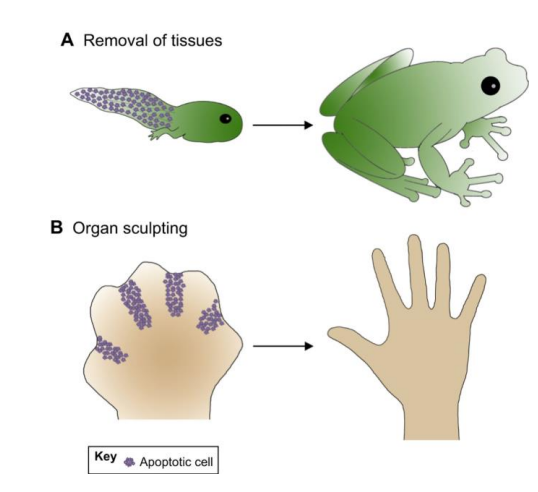
B. Body Systems
➢ tissue=group of cells that all perform the same function
➢ organ=several tissues come together to form specialized structures
➢ Body system=several united organs
- Immune system
- Nervous system
- Endocrine system
- Circulatory
■ Blood vessels carry blood around body to transport chemical signals and to bring supplies to cells and carry waste way
■ The blood flow is controlled by the heart, which pumps blood through the blood vessels - Respiratory
■ Lungs are responsible for gas exchange ($\mathrm{O}_2 $ and$\mathrm {CO}_2$)
■ Help maintain pH levels in blood - Digestive
■ Esophagus, stomach, small intestine, large intestine, pancreas, liver, and gallbladder work together to break down food and absorb nutrients
■ stomach=mixing/breakdown
■ Small intestine=absorption
■ pancreatic=enzyme secretion/secretion - Excretory
■ Kidneys filter blood and reabsorb things the body wants to keep and gets rid of the rest in urine - Reproductive
■ Male and female systems largely controlled by hormones and allow the production of gametes and the ability to reproduce - Muscular and Skeletal
■ Skeletal and smooth muscles contract via an action potential signal from nervous system
■ Skeletal system provides:
● Structure
● Protection
● Calcium storage
C. Immune System
➢ Body’s defense system
➢ pathogens=disease-causing biological agents that can generally be divided into:
- Bacteria
■ Prokaryotes of many shapes and sizes
■ Shapes
● Cocci (sphere)
● Bachi (rod)
● spiral
■ Infect many things
■ Have cell wall
● Maintain cell shape
● Protect cell
● Prevent bursting in hypotonic environment
● Made of peptidoglycan - Archaea contain polysaccharides and proteins
● Gram-positive bacteria have simpler walls with a large amount of peptidoglycan
● Gram-negative bacteria have less peptidoglycan and an outer membrane than can be toxic - More likely to be antibiotic resistant
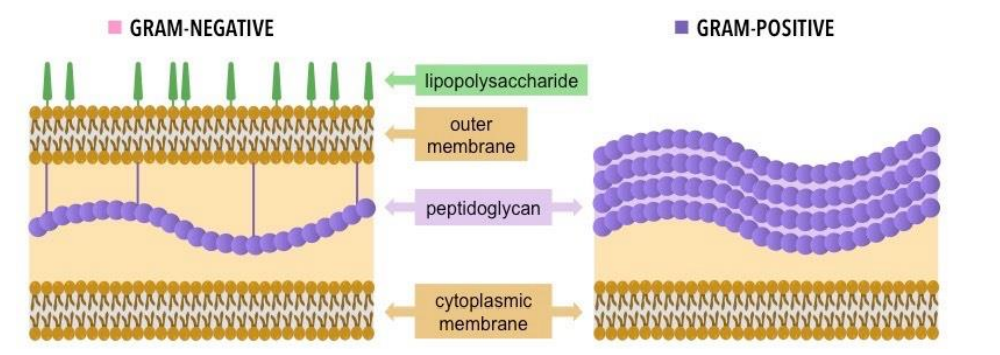
● Capsule: polysaccharide/protein layer covering many prokaryotes
■ Some bacteria develop resistant cells called endospores when that lack an essential nutrient
● thick -coated resistant cell produced by some bacteria cells when exposed to harsh conditions
■ Fimbriae help stick to substrate
■ Contain circular DNA and Plasmids
■ Reproduce by binary fission; short generation times (1-3 hours)
■ May or may not cause harm
■ Divide By fission–does not increase genetic diversity
■ Can perform conjugation with other bacterial cells and swap some DNA
● F-factor=piece of DNA required for production of oil
● Cells containing F Plasmid $\mathrm{(F}^{+}) $serve as donors; Fcells are receivers
● F-factor transferrable during conjugation
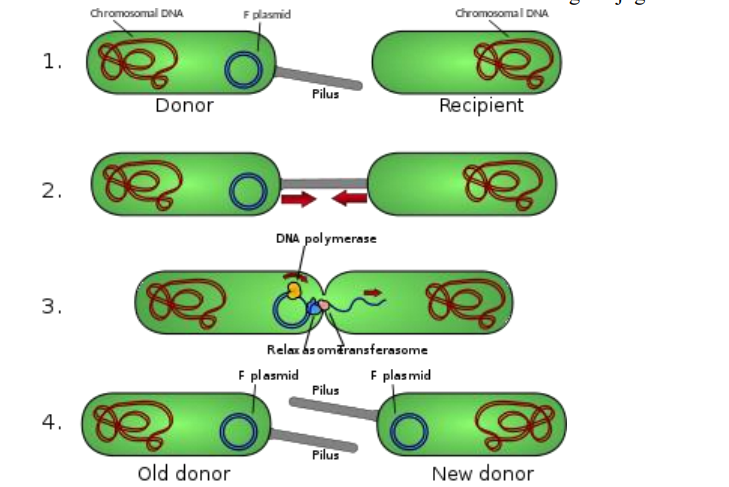
■ Bacterial Transformation
■ Transduction
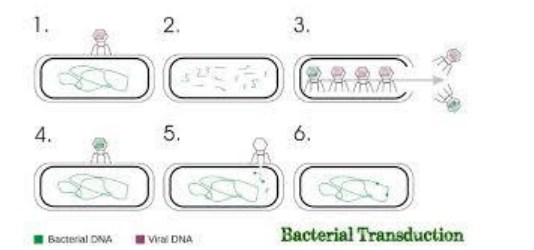
■ Genetic variety among bacteria is leading to increased antibiotic resistance
■ Horizontal gene transfer: movement from one organism to another
- Viruses
■ Non Living agents capable of infecting cells
■ Nonliving bc require a host cell’s machinery to replicate (hijack DNA Polymerase); can’t reproduce on their own
■ envelope:glycoproteins which the cells of animals receive to allow entrance into the virus
● Determines attachment to cell
■ Host range=types of cells virus can infect
■ 2 main components
● Protein capsid - Protein shell enclosing viral genome
- Many shapes: rod, polyhedral, etc.
● Genetic material made up of DNA or RNA, depending upon specific virus
■ Very specific to which cells they infect
■ host=victim cell of viral infection
■ Goal=replicate and spread
● To do so, virus must make more genome and capsid and then these components will self-assemble - Viral genome carries genes for building capsid and anything else the virus needs that the host cell cannot provide
- Sometimes, two viruses will infect a cell and their genomes wil mix
■ Bacteriophage
● 3 cellular defenses against phages - Natural selection
- Restriction enzymes
- lysogeny
● Virus that infects bacteria
● 2 types of replication cycles - Lytic
■ Virulent phages
■ Virus immediately starts using host cell’s machinery to replicate genetic material and create more protein capsids
■ Spontaneously assemble into new viruses and cause cell the lyse, releasing new viruses into the environment - Lysogenic
■ Temperate phages
■ Prophage: viral DNA integrated into bacterial chromosome via lysogenic cycle
■ Virus incorporates itself into host genome and remains dormant until it is triggered to switch into the lytic cycle by an environmental signal
■ During the dormant phase, acell may replicate many times, replicating the viral genome along with it
■ Transduction
● When a virus exercises (becomes unintegrated) from host genome, it sometimes accidentally takes some host NA with it
● New DNA is replicated and packaged into new viral particles, becoming part of other cells
● DNA may have carried a trait such as antibiotic resistance
■ Enveloped viruses
● In animal cells, viruses don’t have to lyse the cell; they can just just exit via exocytosis
● Virus becomes enveloped by a hunk of cell membrane that it takes with it
● Thus these viruses have a lipid envelope
■ Retroviruses
● Eex. HIV
● RNA viruses that use reverse transcriptase to convert their RNA
genomes into DNA so they can be inserted into a host genome
● Extremely high rates of mutation - Lack proofreading mechanisms upon replication
- Difficult to treat
➢ Two immune responses
- Foreign molecules that can trigger an immune response=antigens
- Innate response
■ More general anti-invader response
■ 1st line of defense=skin, mucous lining of respiratory/digestive tract, etc.
■ Other nonspecific defenses
● Phagocytes/macrophages - Engulf antigens
● Complement proteins - Lyse cell wall of antigen
● Interferons - inhibit viral replication
- Activate surrounding cells that have antiviral actions
● Inflammatory responses
○ Series of events in response to antigen invasion/physical injury
● Requires immune cells to recognize foreign substance when it successfully binds to the immune cell’s receptor and activate intracellular signalling pathways
■ Destroys foreign things - Adaptive/Specific Immune Response
■ Carefully catalogs each antigen in a particular way
■ Memory component to help fight repeat attack efficiently
■ Lymphocytes
● Primary cells of immune system
● Found in blood and lymph nodes
● Type of white blood cell (aka leukocyte)
● 2 types
○ B-cell
■ In bone marrow
■ Involved in humoral response
● Defends body against pathogens in extracellular fluids
■ Each B-cell has special receptor on surface than can bind only to foreign antigens
■ If pathogen arrive that fits the receptor, B-cell becomes activated with help of T-cell
■ B-cell will begin to replicate and seek out more of that pathogen
■ Some becomes memory B-cells
● Remain in circulation
● Allows body to mount a quicker response if a second exposure should occur
■ Can also become plasma cell
● Produce antibodies - Specific proteins that bind to same antigen originally activated B-cell
● Antibody produced by plasma cell identical to the surface receptor that originally caught the antigen
■ Each B-cell has a unique receptor/antibody that it makes - T-cell
■ Mature in thymus
■ Involved in cell-mediated immunity
● Responsible for monitoring “self” cells to make sure they are still healthy
● Plasma membrane has major histocompatibility complex (MTOC) markers that allow T-cells to get a glimpse of what is happening inside each cell
■ Have special antigen-recognizing receptors like B-cells
■ MHC I on all nucleated cells
● Take peptides that have been found inside cell and hold them up to surface to let cytotoxic Tcells see
● Cytotoxic T-cell will trigger apoptosis in cell if they decide it is infected
■ MHC II on special immune cells that identify and engulf antigens
● Aka antigen-presenting cells
● Hold up antigen immune cell has picked up to let helper T-cell see
● If T-cell agrees that it is foreign, it helps activate immune cell
➢ Antibodies
- All have same basic monomer structure that is shaped like letter Y
- Stem of Y always the same; can interact with other cells in immune response
- Arms of Y always unique; where antibody binds to antigen
- On each antibody, both arms bind the the same shape so that it can hold 2 antigens at once
- Can combat antigen on its own just by binding to it
■ Antigen can no longer bind to anything else, so it cannot enter any cells
➢ Lymph node
- Mass of tissue found along lymph vessel
- Contains large number of lymphocytes
- Multiply rapidly upon contact with antigen
- Swell when fighting infection
➢ Red blood cells play no part in immune system; only transport oxygen and contain hemoglobin
➢ Vaccines
- After an immune response, memory T-/B-cells are kept around
- “Remember” how to fight previous infection, allowing secondary immune response to be much quicker
- Vaccines are tiny doses of an antigen that have been modified so they’re not dangerous, so memory cells are created without having to go through a real infection
➢ AIDS
- Acquired immunodeficiency syndrome
- Caused by specific infection of helper T-cells by HIV
■ Helper T-cells wiped out, so that there is no immune system
■ Death is not caused by AIDS itself, but rather by an inability to fight off infections
D, The Nervous System
➢ Neurons
- Functional unit of nervous system
- Receive and send neural impulses that trigger organisms’ responses to their environment
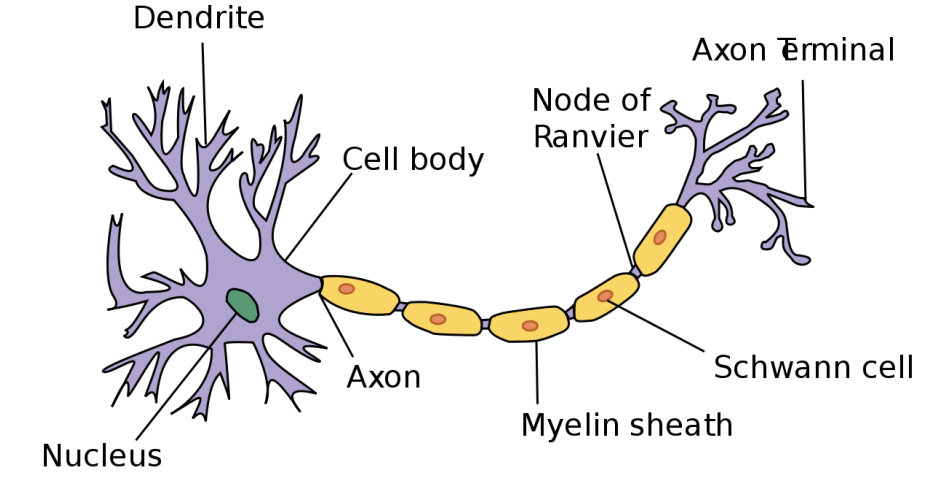
- Dendrites receive stimuli
- Axon transmits signal
- Nerve impulse begins at top of dendrites, passes through cell body, and moves down the axon
➢ How Neurons Communicate
- Within a neuron, the signal is called an action potential
■ Wave of positive charge that sweeps down the axon
■ In order for the signal to be clear, the cell must have a “normal”, non-positive state
■ Resting membrane potential
● Natural charge of a cell
● Represents difference in charge from inside to outside
● Nearly all cells in body have a negative resting state
■ NEgative Resting potential result from 2 activities:
● $Na^{+}K^{+}$ -ATPase pump - Pushes 2 potassium ions into cell for every 3 sodium ions pushed out
- Results in a net loss of positive charge in cell
● Leaky$ K^{+}$ Channels - Some potassium ion channels in membrane are “leaky”, allowing for a slow diffusion of $\mathrm{K}^{+}$ out of cell
■ Membrane potential is always negative in cell, and the neuronal membrane is said to be polarized
➢ Action Potential
- All-or-none response
■ If the stimulus has enough intensity to excite a neuron, the cell reaches its threshold
■ threshold=minimum amount of stimulus a neuron needs to respond
■ When threshold is reached, the cell fires its action potential - 1. Reaching threshold
■ An outside stimulus causes a slight influx of positive charge in the neuron
■ When this influx causes the cell body to reach $-50$mV, threshold is reached - 2.Sodium Channels open (depolarization)
■ -50mV voltage causes the opening of many voltage-gated sodium channels near where the axon meets the cell body
■ Sodium potassium pump has created a higher concentration of sodium outside cell
■ When channels open, sodium ions flow in, increasing the charge
■ Once the membrane reaches $+35$mV, sodium ion channels close again - 3. Potassium Channels Open (Repolarization)
■ As the sodium channels close, potassium channels open
■ Potassium flows out of cell, decreasing membrane voltage
■ Potassium channels close at $-90$mV, and cell returns to resting membrane potential
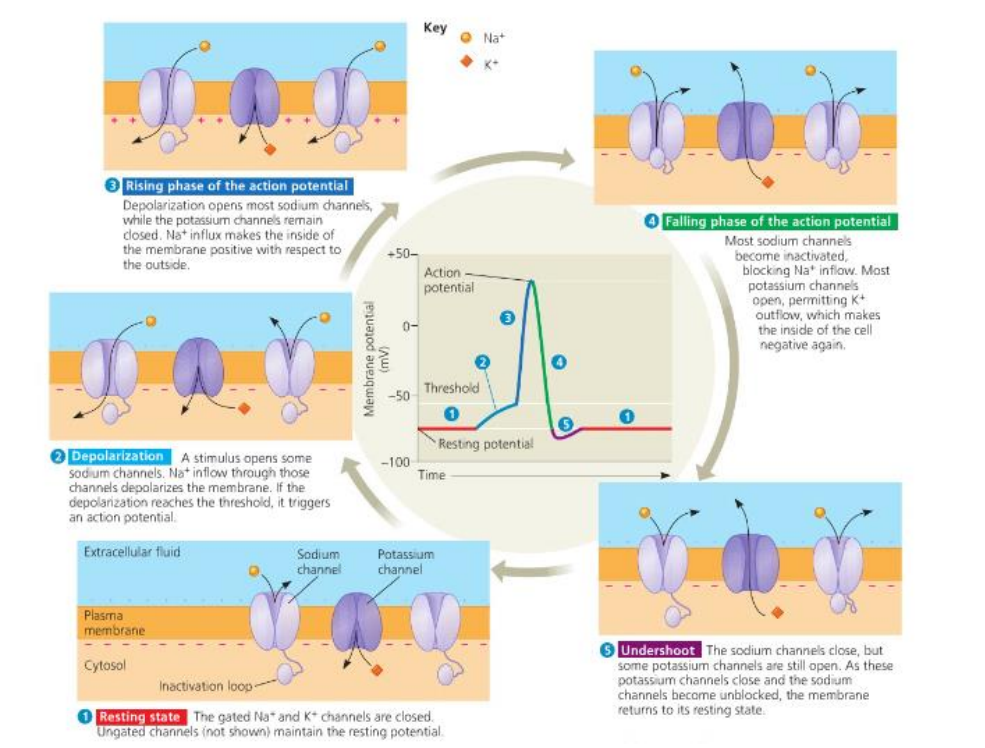
- Ligand attaches to $\mathrm{Na}^{+}$ gate, causing it to enter, increasing the charge near that area. The increase in voltage causes a chain reaction down the membrane of opening $\mathrm{Na}^{+}$ gates until the charge is positive enough to allow the $\mathrm{K}^{+}$ gates to open, decreasing the chargeuntil it has returned to just below its resting state
➢ Refractory Period
- 2 different refractory periods
■ 1. Caused by sodium channels unable to open again right away
■ 2. Cell dips below resting membrane potential - A greater stimulus is needed to reach threshold, so it is more difficult to initiate another action potential right away
➢ Passing along the Signal
- Impulse is transmitted down the axonal membrane until it reaches the axon bulb
- When an impulse reaches the end of a axon, the axon releases chemicals called neurotransmitters into the synapse (space between the two membranes)
■ Cell before synapse=”presynaptic cell”
■ Cell after synapse=”postsynaptic cell”
■ Neurotransmitter diffuses across the synaptic cleft and binds to receptors on the dendrites of the next neuron, triggering an action potential in the cell
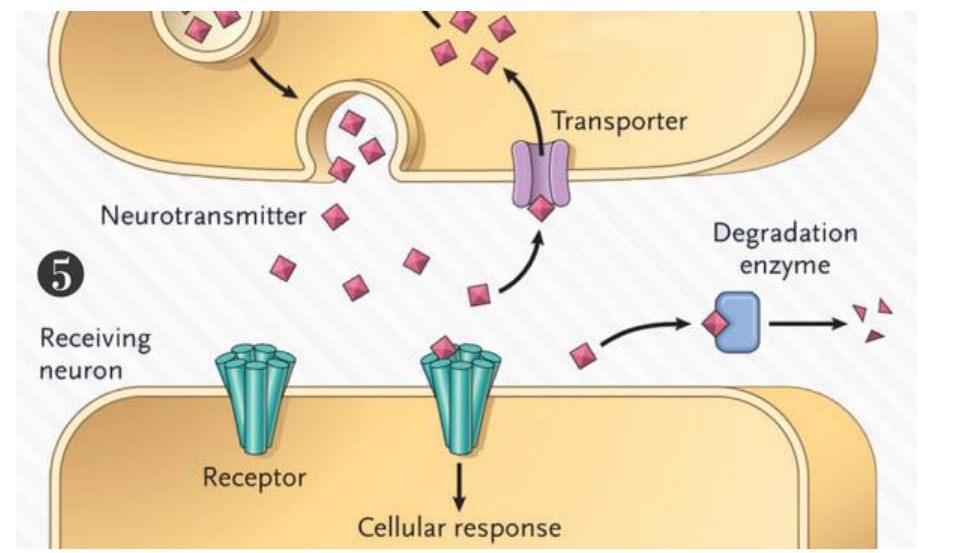
➢ Speed of an Impulse
- Schwann cells
■ Supporting cells that wrap around axon
■ Produce the myelin sheath
● Spaces between myelin sheaths=nodes of Ranvier
● Speed of propagation of an impulse - Impulses jump from node to node instead of across membrane
- Called saltatory conduction
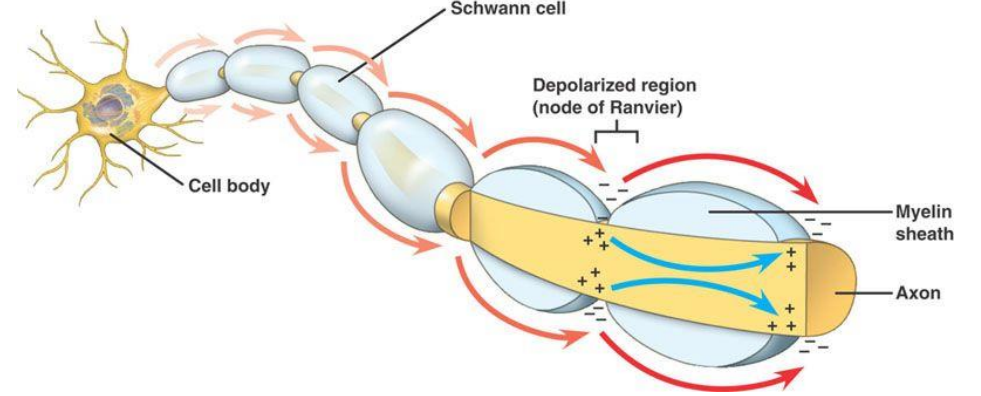
➢ Parts of the Nervous System
- Central Nervous System=All neurons within brain and spinal cord
- Peripheral nervous System=neurons outside brain/spinal cord
➢ Stimulus-Decision-Response Pathway
- Sensory neurons
■ Aka effector neurons
■ Receive impulses from the environment and bring them to body - Interneurons
■ Make decisions about what to with stimuli from sensory neurons - Motor neurons
■ Aka effector neurons
■ Transmit the decision from brain to muscles/glands to produce a response
E. The Endocrine System
➢ Maintains homeostasis
➢ Coordinates responses to stimuli
➢ Hormones produced by endocrine glands
- Hormones are chemical messengers with many functions
■ Ex.
● Growth
● Behavior
● Development
● Reproduction - Hormones flow in blood but only affect target cells
- Operate by a negative feedback system
➢ How Hormones Work
- If a hormone is a steroid (lipid soluble), it can diffuse across the membrane of the target cell
■ Then binds to receptor protein in nucleus, regulating DNA transcription and protein production - If a hormone is a protein/peptide/amine, it must bind to a receptor on plasma membrane
■ Causes signal cascade without hormone ever entering cell
F. Plant Structure and Function
➢ Plants take up water and mineral from below ground
➢ Plants take up $CO_{2}$and light from above ground
➢ Tissues:
- Dermal
- Vascular
- Ground tissues
➢ Root System
- Rely upon sugar produced in photosynthesis
- Root
■ Organ with important functions:
● Anchoring the plant
● Absorbing minerals and water
● Storing carbohydrates - Most eudicots and gymnosperms have a taproot system, which consists of:
■ A tap root, the main vertical root
■ Lateral root, or branch roots, that arise from the taproot - Most monocots have a fibrous root system, which consists of:
■ Adventitious roots that arise from stems or leaves
■ Lateral roots that arise from the adventitious roots - In most plants, absorption of water and minerals occur near the root hairs, where vast numbers of tiny root hairs increase the surface area
➢ Shoot system
- Rely on water and minerals absorbed by root system
- Stems
■ stem=organ consisting of:
● Alternating system of nodes, the points at which leaves are attached
● Internodes, the stem segments between nodes
■ An axillary bud is a structure that has the potential to form a lateral shoot, or branch
■ An apical bud, or terminal bud, is located near the shoot tip and causes elongation of a young shoot
● Apical dominance: apical buds maintain dormancy in axillary buds - Leaves
■ The leaf is the main photosynthetic organ of most vascular plants
■ Leaves generally consist of a flattened blade and a stalk called the petiole, which join the leaf to a node of the stem
■ Monocots and eudicots differ in the arrangements of veins, the vascular tissue of leaves
● Most monocots have parallel veins
● Most dicots have branching veins
➢ Short-Distance Transport in Plants
- xylem:$H_{2}O$ and mineral from the roots up
- Phloem: sugar from leaves to areas of need
- Bulk-Flow=long distance
- Transpiration
■ 1. Water enters roots via osmosis
■ 2. Water moves up xylem cells through capillary action
● Adhesion to cell walls
● Cohesion water to water - When the $H_{2}O$ Molecule leaves through the stomata it pulls the next one up each $H_{2}O$ molecule pulls on the one below all the way down to the leaves
■ 3.Water is lost to the environment due to open stomata
● stomata=open pores in leaves; brings in $CO_{2}$, $H_{2}O$ exits
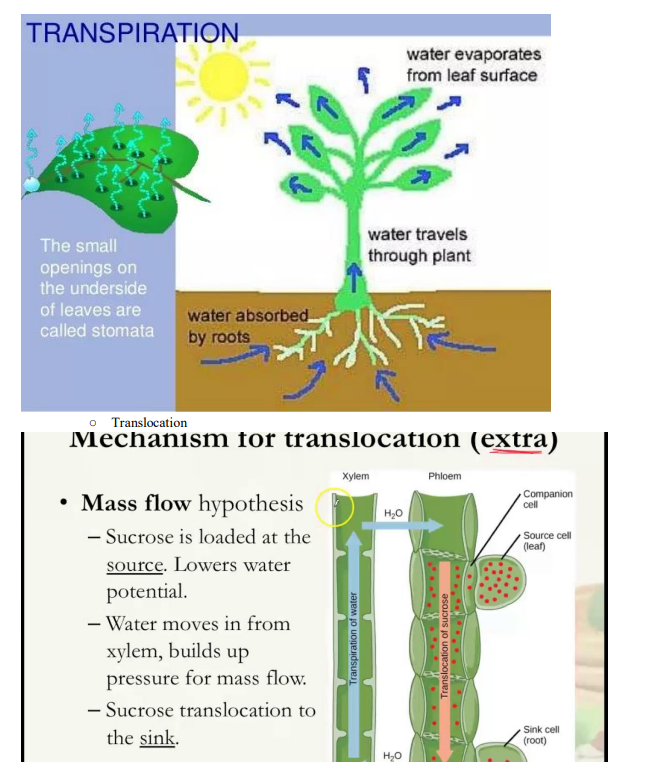
- symplastic=moving directly through the plasmodesmata
- Transmembrane=move straight through walls and membranes via water channels
■ filter/blockade - Casparian Strip
■ Waxy water impervious strip that prevents movement through cell walls
■ Forces transfer to symplastic method
■ Filters out toxins/other unneeded substances
■ Prevents leaks
